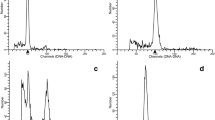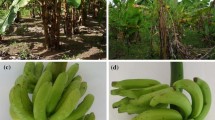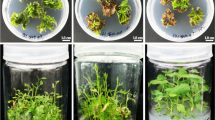Abstract
Populus simonii × P. euphratica cv. ‘Xiaohuyang-1’ is an elite variety produced by distant hybridization between Populus section Tacamahaca and sect. Turanga. However, its highly gametic sterility makes it difficult to be used in the breeding program for the next generation. Induction of amphidiploids derived from the distant hybrid is an ideal approach for the restoration of gametic fertility. In this study, amphidiploids of ‘Xiaohuyang-1’ were produced by a strategy of tetraploid isolation from mixoploid plants based on adventitious bud regeneration. Firstly, in vitro regeneration systems of ‘Xiaohuyang-1’ were established as MS medium with 0.4 mg L− 1 6-BA and 0.05 mg L− 1 NAA for leaf explants, and MS medium with 0.4 mg L− 1 6-BA and 0.1 mg L− 1 NAA for internode-segment explants. Then, 31 mixoploids were induced by treating node segments with colchicine solution. The colchicine concentration, exposure time, and their interaction significantly affected the induction rate of mixoploids. Thirdly, the leaves of mixoploids were used as explants to induce adventitious buds, and 6 amphidiploids were identified from 43 regenerated buds, with an isolation rate of 13.95%. Furthermore, analyses of phenotypic variation among different ploidy levels showed that the amphidiploids had significantly longer, wider, and thicker leaves, larger stomas, and lower stomatal density, compared with the diploids. The notably increased cell sizes of spongy tissue contributed to the increase in leaf thickness of amphidiploids. The amphidiploid plants induced in this study are expected to exhibit better abiotic tolerance and improved gametic fertility, serving as a bridge parent in the next breeding cycle of Populus.






Similar content being viewed by others
Data availability
The datasets generated during and/or analyzed during the current study are available in the figshare repository, https://figshare.com/s/67edc418d7ac4d6bf36d.
References
Ashraf M, McNeilly T (2004) Salinity tolerance in Brassica oilseeds. Crit Rev Plant Sci 23(2):157–174
Bannoud F, Bellini C (2021) Adventitious rooting in Populus Species: Update and Perspectives. Front Plant Sci 12:668837
Barceló-Anguiano M, Holbrook NM, Hormaza JI, Losada JM (2021) Changes in ploidy affect vascular allometry and hydraulic function in Mangifera indica trees. Plant J 108(2):541–554
Beaulieu JM, Leitch IJ, Patel S, Pendharkar A, Knight CA (2008) Genome size is a strong predictor of cell size and stomatal density in angiosperms. New Phytol 179:975–986
Begna T (2020) Review on somatic hybridization and its role in crop improvement. J Biol Agricul Health 10(11):29–40
Biselli C, Vietto L, Rosso L, Cattivelli L, Nervo G, Fricano A (2022) Advanced breeding for biotic stress resistance in poplar. Plants 11(15):2032
Cai X, Kang XY (2011) In vitro tetraploid induction from leaf explants of Populus pseudo-simonii Kitag. Plant Cell Rep 30:1771–1779
Cao Q, Zhang X, Gao X, Wang L, Jia G (2018) Effects of ploidy level on the cellular, photochemical and photosynthetic characteristics in Lilium FO hybrids. Plant Physiol Biochem 133:50–56
Chen LL, Gao SL (2007) In vitro tetraploid induction and generation of tetraploids from mixoploids in Astragalus membranaceus. Sci Hortic 112(3):339–344
Chen S, Polle A (2010) Salinity tolerance of Populus. Plant Biol 12(2):317–333
Chen J, Zhou J, Sun ZH, Tang JR, Duan AA, Wang JF, Xin PY (2013) Study on polyploid induction of Populus yunnanensis Dode by tissue culture combined with colchicine. J Yunnan Agricul Univ 28(2):251–256
Çürük S, Dayan A (2018) Production of diploid and amphidiploid interspecific hybrids of eggplant and Solanum Torvum, and pollen fertility. J Anim Plant Sci 28(5):1485–1492
Eng WH, Ho WS, Ling KH (2021) In vitro induction and identification of polyploid Neolamarckia cadamba plants by colchicine treatment. Peer J 9:e12399
Fujishige I, Tanaka R, Taniguchi K (1996) Efficient isolation of nonchimeric tetraploids artificially induced in a stable culture of Haplopappus gracilis. Theor Appl Genet 92(2):157–162
Galbraith DW, Harkins KR, Maddox JM, Ayres NM, Sharma DP, Firoozabady E (1983) Rapid flow cytometric analysis of the cell cycle in intact plant tissues. Science 220:1049–1051
García-Angulo P, Villaw I, Giner-Robles L, Centen ML (2018) In vitro regeneration for two Populus hybrid clones. The role of pectin domains in cell processes underlying shoot organogenesis induction. Biol Plant 62(4):763–774
Gaur A, Kumar P, Thakur AK, Srivastava DK (2015) In vitro plant regeneration studies and their potential applications in Populus spp.: a review. Isr J Plant Sci 63(2):1–8
Jiranapapan J, Kikuchi S, Manochai B, Taychasinpitak T, Tanaka H, Tsujimoto H (2011) A simple method of chromosome doubling using colchicine in Torenia (Linderniaceae), and the behavior of meiotic chromosomes in amphidiploids. Chromosome Sci 14(1––2):29–32
Kang XY (2016) Polyploid induction techniques and breeding strategies in poplar. In: Mason AS (ed) Polyploidy and hybridization for crop improvement. CRC Press, Boca Raton, pp 76–96
Kiani R, Arzani A, Maibody S, Rahimmalek M, Ayers T (2021) Hybridization of wheat and Aegilops cylindrica: development, karyomorphology, DNA barcoding and salt tolerance of the amphidiploids. J Plant Biochem Biotechnol 30:943–959
Kondorosi E, Roudier F, Gendreau E (2000) Plant cell-size control: growing by ploidy? Curr Opin Plant Biol 3:488–492
Kumar S, Imtiaz M, Gupta S, Pratap A (2011) Distant hybridization and alien gene introgression. In: Pratap A, Kumar J (eds) Biology and breeding of food legumes. CABI, Oxfordshire, pp 81–110
Lim KB, Kwon SJ, Lee SI, Hwang YJ, Naing AH (2012) Influence of genotype, explant source, and gelling agent on in vitro shoot regeneration of chrysanthemum. Horticul Environ Biotechnol 53(4):329–335
Liu D, Zhang H, Zhang L, Yuan Z, Hao M, Zheng Y (2014) Distant hybridization: a tool for interspecific manipulation of chromosomes. In: Pratap A, Kumar J (eds) Alien gene transfer in crop plants, vol 1: innovations, methods and risk assessment. Springer, New York, pp 25–42
Liu W, Zheng Y, Song S, Huo B, Li D, Wang J (2018) In vitro induction of allohexaploid and resulting phenotypic variation in Populus. Plant Cell Tiss Organ Cult 134:183–192
Liu W, Song S, Li D, Lu XC, Liu JR, Zhang JW, Wang J (2020) Isolation of diploid and tetraploid cytotypes from mixoploids based on adventitious bud regeneration in Populus. Plant Cell Tiss Organ Cult 140:1–10
Lv W, Zhang WD, Bao J (2000) Discussion of developing poplar plantation and construction of protection forests in three north area. Protect for Sci Technol 43:67–69
Maheshwari P, Kovalchuk I (2016) Agrobacterium-mediated stable Genetic Transformation of Populus angustifolia and Populus balsamifera. Front Plant Sci 7:296–308
Mondin M, Silva PAKXDE, Latado RR, Mourao FDA (2018) In vitro induction and regeneration of tetraploids and mixoploids of two cassava cultivars. Crop Breed Appl Biotech 18(2):176–183
Murashige T, Skoog F (1962) A revised medium for rapid growth and bio assays with tobacco tissue cultures. Physiol Plant 15:473–497
National Forestry and Grassland Administration (2019) China forest resources report (2014–2018). China Forestry Publishing House, Beijing
Nimura M, Kato J, Horaguchi H, Mii M, Sakai K, Katoh T (2006) Induction of fertile amphidiploids by artificial chromosome-doubling in interspecific hybrid between Dianthus caryophyllus L. and D. japonicus Thunb. Breed Sci 56(3):303–310
Qi CY, Wei DW, Hu YJ, Wang XM (2015) The reforestation of agricultural protection forest. J Jilin for Sci Technol 44(4):59–60
Roy A, Leggett G, Koutoulis A (2001) In vitro tetraploid induction and generation of tetraploids from mixoploids in hop (Humulus lupulus L). Plant Cell Rep 20(6):489–495
Rugini E, Pannelli G, Ceccarelli M, Muganu M (1996) Isolation of triploid and tetraploid olive (Olea europaea L.) plants from mixoploid cv. ‘Frantoio’ and ‘Leccino’ mutants by in vivo and in vitro selection. Plant Breed 115(1):23–27
Ruzin SE (1999) Plant microtechnique and microscopy. Oxford University Press, New York
Singh RJ, Nelson RL, Abbo S (2015) Methodology for creating alloplasmic soybean lines by using Glycine tomentella as a maternal parent. Plant Breed 133(5):624–631
Tian J, Zhu J, Wang Y, Zhang J, Wang J, Li G (2016) Regularities of the ion uptake and allocation characteristics for Populus simonii × P. euphratica varieties under NaCl stress. J Northwest for Univ 31(6):65–70
Touchell DH, Palmer IE, Ranney TG (2020) In vitro ploidy manipulation for crop improvement. Front Plant Sci 11:722
Trojak-Goluch A, Kawka-Lipińska M, Wielgusz K, Praczyk M (2021) Polyploidy in industrial crops: applications and perspectives in plant breeding. Agronomy 11:2574
Wang J, You HL, Tian J, Wang YF, Liu MH, Duan WL (2015) Abnormal meiotic chromosome behavior and gametic variation induced by intersectional hybridization in Populus L. Tree Genet Genom 11(3):1–11
Wang J, Huo B, Liu W, Li D, Liao L (2017) Abnormal meiosis in an intersectional allotriploid of Populus L. and segregation of ploidy levels in 2x × 3x progeny. PLoS ONE 12(7):e0181767
Yan X, Zhang J, Zhang H (2021) Induction and characterization of tetraploids in poplar. Plant Cell Tiss Organ Cult 146(10):185–189
Yang HW, Zhang FG, Fu GS (1984) Selection and breeding of salinity tolerant poplar hybrid ‘Populus simonii × P. euphratica – 1’. J Inner Mongolia for Sci Technol 4:1–6
Yao CL, Pu JW (1998) Timber characteristics and pulp properties of the triploid of Populus tomentosa. J Beijing for Univ 20:18–21
Zeng Q, Han Z, Kang X (2019) Adventitious shoot regeneration from leaf, petiole and root explants in triploid (Populus alba × P. glandulosa) × P. tomentosa. Plant Cell Tiss Organ Cult 138:121–130
Zhang S, Qi L, Chen C, Li X, Song W, Chen R, Han S (2004) A report of triploid Populus of the section Aigeiros. Silvae Genet 53:69–75
Zhang YS, Chen JJ, Cao YM, Duan JX, Cai XD (2020) Induction of tetraploids in ‘Red flash’ caladium using colchicine and oryzalin: morphological, cytological, photosynthetic and chilling tolerance analysis. Sci Hortic 272:109524
Zhu ZT, Lin HB, Kang XY (1995) Studies on allotriploid breeding of Populus tomentosa B301 clones. Sci Silvae Sin 31:499–505
Acknowledgements
This work was supported by The National Key R&D Program of China during the 14th Five-year Plan Period (Grant No. 2021YFD2200104).
Author information
Authors and Affiliations
Contributions
J.W. conceived and designed research. Y.Z., Z.Y.W., X.T.C., and X.X.Z. conducted experiments and analyzed data. J.W.Z. cultivated the materials. L.T. observed the phenotypic variation. Y.Z., Z.Y.W., and J.W. wrote the manuscript. All authors read and approved the manuscript.
Corresponding author
Ethics declarations
Conflict of interest
The authors declare that they have no competing interests.
Additional information
Publisher’s Note
Springer Nature remains neutral with regard to jurisdictional claims in published maps and institutional affiliations.
Ying Zhang, Zi-Yu Wang and Xiao-tong Cui contributed equally to this work.
Rights and permissions
Springer Nature or its licensor (e.g. a society or other partner) holds exclusive rights to this article under a publishing agreement with the author(s) or other rightsholder(s); author self-archiving of the accepted manuscript version of this article is solely governed by the terms of such publishing agreement and applicable law.
About this article
Cite this article
Zhang, Y., Wang, ZY., Cui, XT. et al. Amphidiploid production of a distant hybrid Populus simonii × P. euphratica cv. ‘Xiaohuyang-1’ and resulting in phenotypic variation. New Forests (2023). https://doi.org/10.1007/s11056-023-10003-z
Received:
Accepted:
Published:
DOI: https://doi.org/10.1007/s11056-023-10003-z




